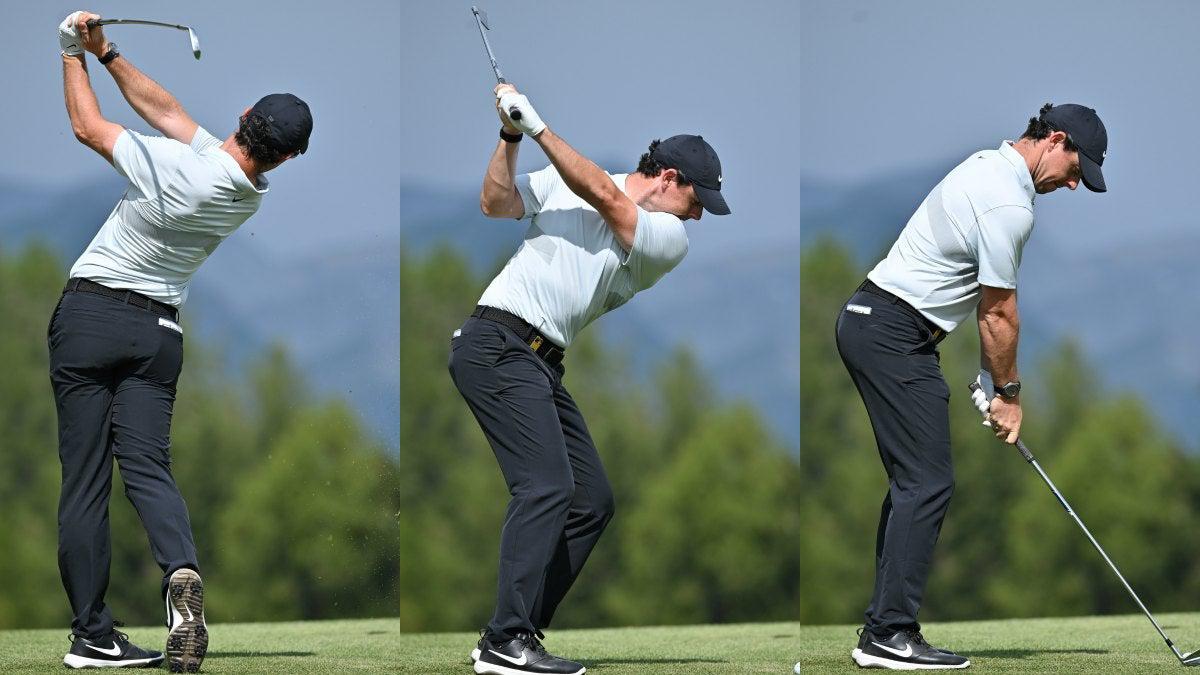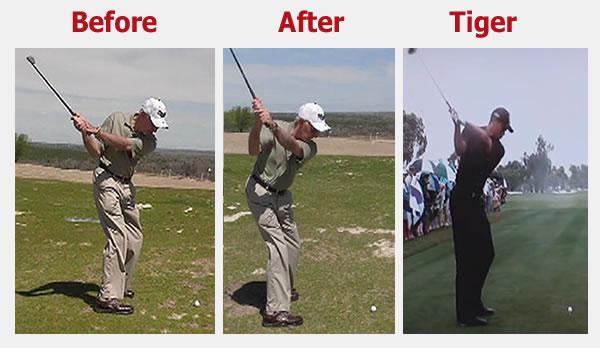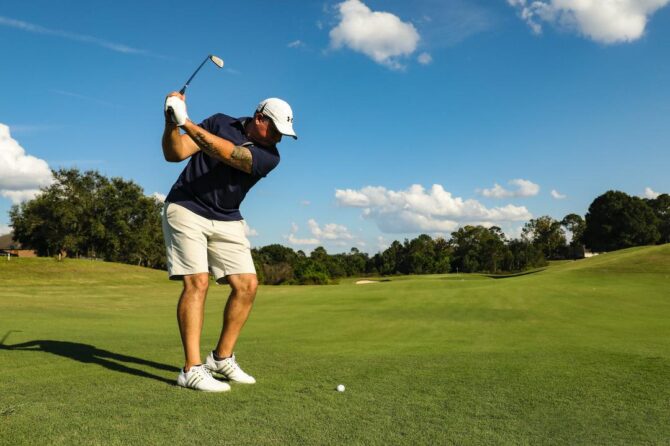The golf swing follow-through is a crucial element that significantly influences the accuracy and consistency of shots. Skilled golfers execute a refined follow-through characterized by specific biomechanical principles. Here are key insights and recommendations to optimize your follow-through for enhanced accuracy and control:
Maintaining Balanced Weight Distribution:
- Preserve balanced weight distribution between both feet upon impact to foster stability and control.
- Avoid shifting weight excessively to the trail foot to prevent loss of balance and diminished accuracy.
Extension and Release:
- The follow-through requires complete extension of the arms and a release of the clubhead.
- Extend the arms fully towards the target while simultaneously releasing the clubhead for proper clubhead speed and enhanced accuracy.
Swing Rotation:
- Sustain the rotation of the body and swing during the follow-through.
- Rotate the shoulders and hips completely through the shot to maintain accuracy by preserving the swing plane.
Refining the Follow-Through for Precision and Consistency:
- Begin the follow-through as the clubhead strikes the ball and maintain balance and control throughout the movement.
- Allow the club to extend fully during the follow-through to ensure accuracy and distance.
- Focus on proper body rotation and arm extension for maximum power generation and accuracy.
Fundamentals of the Golf Swing Follow-Through:
- Extension and Rotation: Ensure a powerful extension of the arms and rotation of the torso for force and momentum.
- Proper Wrist and Shoulder Position: Maintain a neutral wrist position and stable shoulders for consistent shots.
- Clubhead Path: Guide the clubhead along an outside-in path for a clean strike and controlled ball flight.
Key Principles of the Golf Follow-Through:
- Maintaining Balance and Posture: Evenly distribute weight with a straight spine for optimal club control and consistency.
- Extension and Rotation: Fully extend arms and rotate the body for maximum power generation.
- Acceleration and Clubhead Speed: Contribute to clubhead speed and acceleration for increased ball velocity.
Techniques for Improving the Golf Follow-Through:
- Practice maintaining a balanced and stable posture with feet shoulder-width apart and weight evenly distributed.
- Achieve full extension and rotation by gradually increasing swing arc and focusing on arm and body movement.
By implementing these principles and techniques into your golf follow-through, you can enhance your accuracy, control, and overall performance on the course.

Dissecting the Biomechanics of an Optimal Follow-Through
Dissecting the Biomechanics of an Optimal Follow-Through
The follow-through in a golf swing is a crucial phase that significantly impacts accuracy and control. By understanding the biomechanics involved, golfers can optimize their follow-through technique to achieve desired results.
The initial focus should be maintaining shoulder-waist separation. Proper dissociation between these areas allows for increased shoulder rotation and optimal clubhead speed. This separation is critical for generating power and delivering the ball with precision.
Additionally, body balance plays an essential role. As the downswing concludes, the weight should gradually shift to the front foot while the back remains stable. This balanced position promotes stability, control, and consistent shot trajectory. A table demonstrating the biomechanical sequence of an optimal follow-through is provided below:
| Phase | Biomechanics |
|---|---|
| Transition | Maintain shoulder-waist separation, initiate body rotation |
| Weight Shift | Shift weight to front foot, maintaining a stable back |
| Shoulder Rotation | Continue shoulder rotation through impact, increasing clubhead speed |
| Balance | Maintain a balanced position, ensuring control and stability |
| Clubhead Release | Extend arms and release clubhead through follow-through |
Mastering the precision and control of the golf swing through an optimized follow-through
Executing a seamless follow-through in golf is pivotal in achieving enhanced accuracy and control on the course. The follow-through phase of the swing initiates upon impact, encompassing the post-impact continuation of the swing arc and the subsequent finish position. Highly skilled golfers showcase a refined technique in their follow-through, characterized by several essential elements. Primarily, these elements involve maintaining extension of the arms, rotating the torso, and balancing the weight correctly. By adhering to these principles and incorporating them into their technique, golfers can significantly improve their accuracy and consistency.
1. Maintaining Arm Extension
* Extend arms fully, with the right shoulder situated lower than the left just after impact.
* Rotate torso while keeping arms extended.
* Maintain balance throughout follow-through.
* Head remains down until impact.
2. Rotating the Torso
* Rotate torso to follow through swing.
* Weight shifts to the left foot.
* Spine angle approximates 45 degrees at finish.
* Chin is level at finish.
3. Balancing Weight Correctly
* Balance weight evenly on your feet after impact.
* Distribute weight slightly to the left side to stabilize.
* Stable finish ensures distance and control.
* Knees remain slightly flexed.
Fine-Tune Your Wrist Position: Maintaining proper wrist position is paramount for optimal accuracy. Throughout the golf swing, the wrists should remain relatively flat. As the club approaches impact, begin a gradual release, allowing the wrists to hinge slightly. This hinge motion will impart a controlled spin on the ball, resulting in increased accuracy and trajectory.
Maintain Shaft Angle: A consistent shaft angle is crucial for a precise follow-through. After impact, resist any tendency to release the shaft too early or drop it abruptly. Instead, focus on maintaining a gradual forward rotation while keeping the shaft angle roughly parallel to the target line. This will minimize unwanted hooks or slices and promote straighter, more accurate shots.
Balance and Poise: The follow-through concludes the golf swing, and a graceful and balanced finish will contribute to overall stability and consistency. Extend your arms and club fully along the target line, allowing the head to turn naturally with the swing. Maintain a balanced stance with feet shoulder-width apart to complete the swing with poise and control. This graceful follow-through will promote swing stability and improve shot accuracy.
Maximizing Distance and Accuracy Through a Controlled Release
Maximizing Distance and Accuracy Through a Controlled Release
To achieve optimal distance and accuracy in your golf shots, it is crucial to master the controlled release of the club. This technique involves maintaining a consistent grip, swing path, and follow-through to ensure a smooth and powerful impact with the ball.
By properly aligning your body, keeping your head still, and rotating your hips and shoulders in unison, you can create a stable and repeatable swing that generates maximum clubhead speed. Additionally, focusing on a controlled release will allow you to better control the trajectory and spin of the ball, enabling you to hit shots with greater precision and distance.
Furthermore, maintaining a relaxed grip and avoiding excessive tension in your arms and wrists will help you execute a smooth and fluid swing. This will result in increased consistency and accuracy, as well as reduced risk of injury. By practicing and refining your controlled release, you can significantly improve your overall golf performance and consistently deliver powerful and accurate shots.
Follow-Through: Essential for Enhanced Accuracy in Golf
The follow-through in a golf swing plays a crucial role in achieving enhanced accuracy and control over the ball’s trajectory. It encompasses the movements that immediately follow the impact of the club with the ball. Skilled golfers execute a refined follow-through characterized by specific biomechanical principles. This section delves into the intricacies of the follow-through, providing a comprehensive understanding of its key elements and offering practical recommendations for optimizing accuracy and consistency on the course.
Key Principles of the Follow-Through
-
Maintain Extension: After impact, it is essential to maintain extension in both the arms and the spine. The arms should be fully extended, with the right shoulder lower than the left, creating a straight line from the clubhead to the target. This extension helps to generate power and control clubhead speed, contributing to a more accurate and consistent shot.
-
Balance and Stability: The follow-through requires maintaining a balanced and stable body position. The weight should be gradually shifted to the left foot as the clubhead swings through, ensuring stability and preventing any undesirable lateral movement that could affect accuracy.
-
Finish Position: The follow-through concludes with a balanced finish position. The golfer should stand tall, with their shoulders square to the target and their weight evenly distributed between both feet. This stable and balanced finish helps to minimize any post-impact oscillations that could compromise accuracy.
Refining Your Follow-Through for Increased Accuracy
-
Practice Swing Drills: To refine your follow-through, engage in regular practice swing drills. Focus on maintaining arm and spine extension throughout the swing, while paying attention to the weight distribution and balance.
-
Analyze Video Footage: Record yourself practicing follow-throughs and analyze the footage to identify any areas for improvement. This self-assessment can highlight subtle flaws and help you develop targeted practice drills to address specific weaknesses.
-
Seek Professional Guidance: Consider seeking personalized guidance from a qualified golf instructor or coach. A professional can observe your swing dynamics, provide tailored feedback, and guide you in developing an efficient and accurate follow-through that complements your overall swing technique.
By understanding the key principles outlined above and implementing the practical recommendations provided, golfers can optimize the follow-through phase of their swing, ultimately leading to enhanced accuracy and greater control over their shots. Remember, a refined follow-through is a cornerstone of a repeatable and effective golf swing, allowing you to play with confidence and precision on the course.
Perfecting the Finish: The Ultimate Follow-Through
The follow-through is an often-overlooked aspect of the golf swing that can have a significant impact on accuracy and control. By perfecting the finish, golfers can maximize their distance, accuracy, and consistency.
There are several key elements to a proper follow-through. First, the golfer should keep their head down and their eyes focused on the ball until after it has been struck. This will help to ensure that the club is swung through the ball with a consistent path. Second, the golfer should extend their arms fully and rotate their hips and shoulders through the shot. This will help to generate power and accuracy. Third, the golfer should finish with their weight on their front foot and their body in a balanced position. This will help to ensure that the club is released squarely and that the ball is hit with the desired trajectory.
By practicing these key elements, golfers can improve their follow-through and take their game to the next level. Here are some additional tips for perfecting the follow-through:
* Keep your head down and your eyes focused on the ball until after it has been struck.
* Extend your arms fully and rotate your hips and shoulders through the shot.
* Finish with your weight on your front foot and your body in a balanced position.
* Practice your follow-through regularly until it becomes second nature.
By following these tips, you can master the follow-through and improve your accuracy, control, and consistency on the golf course.
Refining Ball Striking Consistency with a Precise Follow-Through Plan
Refining Ball Striking Consistency with a Precise Follow-Through Plan
The follow-through is an often-underestimated component of the golf swing, yet it plays a pivotal role in determining not just the distance but also the accuracy and consistency of your shots. A precise follow-through plan helps you maintain control over the clubhead throughout the swing, ensuring that it strikes the ball squarely and consistently.
To refine your ball-striking consistency, start by understanding the key elements of an effective follow-through. Immediately after impact, ensure that your weight is balanced over the balls of your feet, with your head and spine steady. Maintain a firm, relaxed grip on the club, allowing it to rotate naturally through your hands as you extend your arms towards the target.
Further, focus on maintaining the angle of the clubface as you swing through the ball. This means avoiding any excessive wrist movement or abrupt changes in hand position. By keeping the clubface square to the target, you encourage the ball to travel in a straight line, significantly reducing the risk of slicing or hooking the ball. Regular practice is vital to master the follow-through. Work on drills that isolate this phase of the swing, such as hitting balls from a tee with a shortened backswing. Start at the top of the backswing and concentrate on making a smooth, controlled follow-through, ensuring proper weight transfer and a firm but relaxed grip.
Balance and Stability
Maintaining balance and stability throughout the follow-through is crucial for controlling the clubface. The hips should remain steady, while the weight should shift smoothly from the back foot to the front. A strong core and flexible glutes will help golfers maintain this balance and generate power from the ground up.
Clubhead Rotation
The clubhead should continue to rotate throughout the follow-through. The left wrist (for right-handed golfers) should maintain its angle, encouraging the clubface to close and square at impact. By preventing the clubhead from flipping or opening, golfers can improve their accuracy and achieve a more controlled ball flight.
Path and Plane
The club should follow a specific path and plane throughout the swing, including the follow-through. The club’s path should be slightly inside-out, while the plane should be shallow to promote a descending angle of attack. Keeping the club on the correct path and plane will enhance consistency and reduce tendencies for hooks or slices.
Mastering the follow-through in golf is indispensable for achieving enhanced accuracy and control on the course.
Firstly, the **follow-through produces clubhead speed, which in turn directly influences distance and accuracy.** The follow-through is the ‘push-through’ or ‘pull-through’ motion on the downswing, from the impact zone, where the club makes





